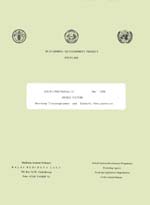
 |
COCKLE CULTURE |
| INS/81/008/MANUAL/12 | May 1988 |
| Banchong Tiensongrusmee and Soehardi Pontjoprawiro | |
Project Document Identification
PART II F. Activities
Prepare seafarming manuals and other technical/information serials
Hyperlinks to non-FAO Internet sites do not imply any official endorsement of or responsibility for the opinions, ideas, data or products presented at these locations, or guarantee the validity of the information provided. The sole purpose of links to non-FAO sites is to indicate further information available on related topics.
This electronic document has been scanned using optical character recognition (OCR) software. FAO declines all responsibility for any discrepancies that may exist between the present document and its original printed version.
3.1 Sheltered area
3.2 Substrate
3.3 Water depth
3.4 Land elevation
3.5 Water movement
3.6 Salinity
4.1 Preparation of culture site
4.2 Source of seed
4.3 Stocking density
4.4 Sowing of cockle spat
4.5 Culture period
4.6 Growth
4.7 Mortality and predation
4.8 Pollution
4.9 Management
4.10 Production
4.11 Case study : cockle culture trial in Tg. Balai
Asahan, Medan
5.1 Small-scale operation
5.2 Commercial operation
5.3 Sensitivity analysis
Table 1. Volume and value of cockle production from 1979–1985
Table 2. Cockle production by location 1981–1985 (mt)
Table 3. Estimated capital investment of a 5-ha cockle farm.
Table 4. Estimated annual cost of production of a 5-ha cockle farm.
Table 5. Cost-benefit analysis of a 5-ha cockle farm
Table 6. Cash flow of a 5-ha cockle farm.
Table 7. Estimated capital investment of a 50-ha cockle farm.
Table 8. Estimated annual cost of production of a 50-ha cockle farm
Table 9. Cost-benefit analysis of a 50-ha cockle farm.
Table 10. Cash flow of a 50-ha cockle farm
Figure 1. Cockle (Anadara granosa L).
Figure 3. Diagram of the wooden “mud sled”
Figure 4. The gear used for harvesting cockle
Figure 5. Hydraulic dredge for harvesting cockle
Figure 6. Hydraulic dredge-showing the delivery of the cockle to the collecting screen